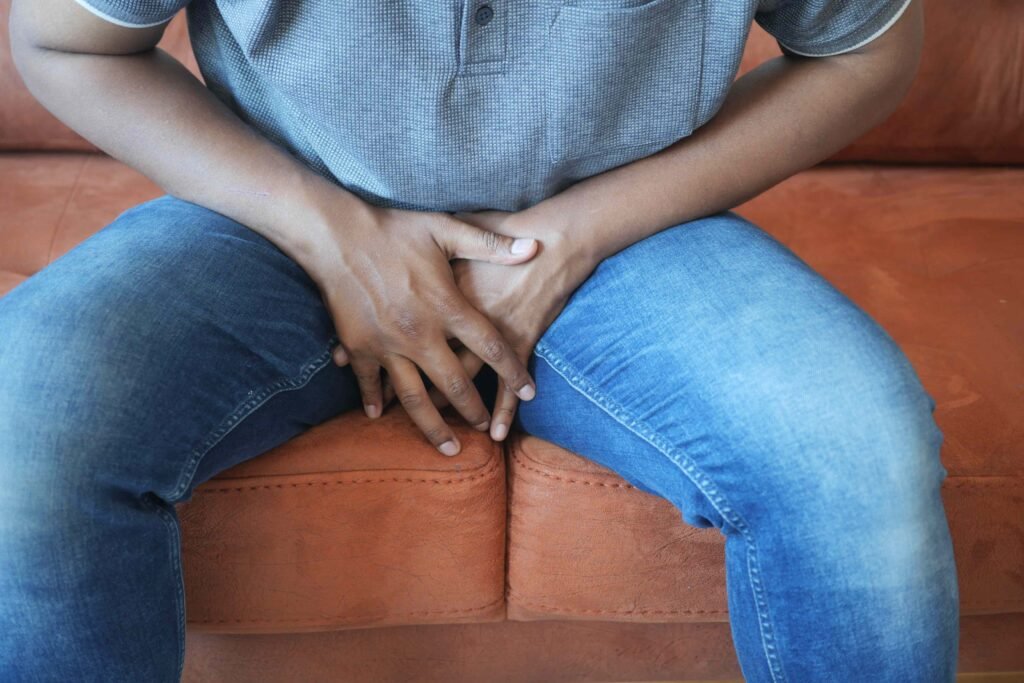A urinary tract infection (UTI) occurs when you have an infection in the kidneys, bladder, and ureters, which are the tubes that carry urine from the kidneys to the bladder. While this infection is more common in people born female, people born male can also get it. You can also get UTIs at all ages. However, male UTIs usually affect adults over 50.
Male UTIs occur when bacteria enter through the urethra (where urine comes out) and spread to the urinary tract (the tubes that remove urine). As the immune system fights the infection, the tissues in the urinary tract become inflamed. This causes swelling, narrowing the pathway urine takes out of the body.
How UTIs feel varies from person to person and depends on the area affected in the urinary tract. UTIs mainly affect how peeing feels and your behaviors around urination. Common signs of a UTI in men include:
- Peeing more frequently, while also peeing less
- Frequent intense urges to pee
- Dysuria, or burning and pain when peeing
- Discomfort around the bladder area
- Difficulty or pain when starting to pee
- The need to pee wakes you up at night
In most cases, these symptoms set on suddenly, and without treatment, they can come back or get worse. In some cases, people may experience no symptoms (asymptomatic bacteriuria).
Male UTI symptoms depend on the part of the urinary tract that’s affected. This includes the lower UTIs, which affect the bladder and ureter, such as cystitis (bladder infection) and urethritis (urethral infection). There are also upper UTIs, which affect the kidneys and ureters, such as ureteritis ( ureter infection), and pyelonephritis (kidney infection).
Cystitis
Cystitis is a condition that affects the bladder and is the most common type of male UTI. In addition to causing typical UTI symptoms like a frequent need to urinate and pain with urination, other signs of this infection include:
- Hematuria, or blood in urine, which gives it a pink or brown color
- Foul-smelling, cloudy urine
- Pain or discomfort in the pelvis (hip area)
- Incontinence (loss of bladder control) at night or bedwetting without a previous history of it
Urethritis
Urethritis often occurs from sexually transmitted infections (STIs) like gonorrhea or chlamydia. Symptoms include:
- Inflammation along the urethra
- Pain and burning when you pee
- Redness or discoloration around the opening at the tip of the penis.
- Milky, yellow, or white discharge from the urethra
Upper UTI Symptoms
Upper UTIs can happen when infections spread from the urethra or the bloodstream to the upper urinary tract, which includes the kidneys and ureters. Infections that spread to the ureters, the two tubes connecting the kidneys to the bladder, cause ureteritis. When the infection spreads to the kidneys, you develop pyelonephritis. Pyelonephritis can affect one or both kidneys.
Upper UTIs are generally more severe than lower UTIs and can cause a range of additional symptoms, including:
- Pain in the abdomen or flank, the section of the body below the ribs and above the pelvis.
- Fever
- Hematuria
- Chills
- Nausea and vomiting
- Weight loss and inability to get enough nutrition (anorexia)
- Fatigue or lack of energy (malaise)
UTI Symptoms in Older Adults
In older adults, upper and lower UTIs can cause additional symptoms, including
- Irritability or grouchiness
- Changes in mental health, such as mood swings
- Confusion, challenges with thinking, remembering, and reasoning
- Appetite loss
- Nausea or vomiting
- Kidney failure, which can cause a metallic taste in the mouth, swollen hands and feet, muscle cramps, itchiness, difficulty sleeping, and breathing difficulties
- Unsteadiness, falls, dizziness
- Drowsiness and chronic (long-term) fatigue
While UTIs more commonly affect older men, infants and children can also develop them. About 1.7% of males 7 years old and younger develop this condition, compared to 8.4% of females in that same age range.
In boys, male UTI symptoms vary based on age and individual case. Common signs include:
- Fever
- Vomiting
- Difficulty feeding in infants
- Failure to thrive in infants, slowed growth or development
- Hypothermia, which is when the body temperature is dangerously low
- Jaundice (yellowing of the eyes or skin)
- Grouchiness or crying
- Peeing more often
- A more frequent need to pee
- Cloudy or smelly urine
- Burning or pain when peeing
- Crying when peeing
- Itchiness and scratching
- Pain in the pelvis, back, or groin
No, UTIs aren’t contagious, and you can’t get one from your partner. However, certain sexual practices, especially anal sex, can expose skin and raise your UTI risk.
Some types, especially urethritis, can arise due to gonorrhea and chlamydia, which spread through vaginal, anal, or oral sex. These STIs can trigger UTIs and are a common cause of UTI symptoms in younger adults. Practicing safe sex, such as wearing condoms, helps prevent STIs and lowers your risk of UTIs.
Since UTIs, like other infections, can get worse without treatment, seek medical care if you or a loved one has any symptoms. It’s especially important to get help if your symptoms are severe and impacting your daily life. Seek emergency care if an infant under three months old has UTI symptoms and a fever above 100.4 degrees Fahrenheit.
While urinary tract infections (UTIs) more commonly affect women, men can also develop them. It happens when a lot of bacteria enter the urethra, bladder, ureters, and kidneys. Common signs of male UTI include burning, pain, or difficulty with urination. More severe cases can cause pink or cloudy urine, pelvic pain, fever, nausea, and vomiting. Seek medical care if you have symptoms of UTI. If you’re diagnosed with one, a doctor will prescribe antibiotics to treat and cure it.

